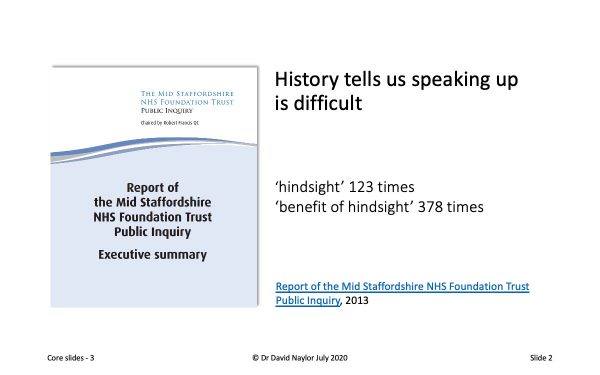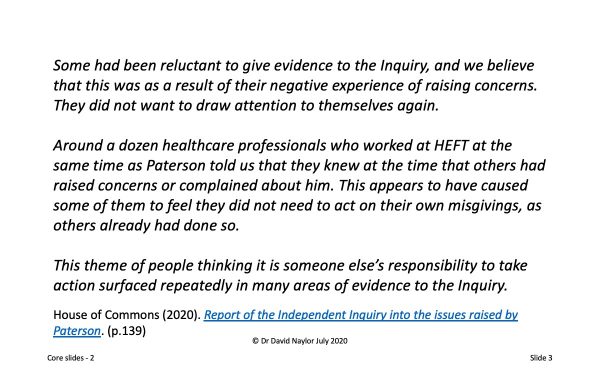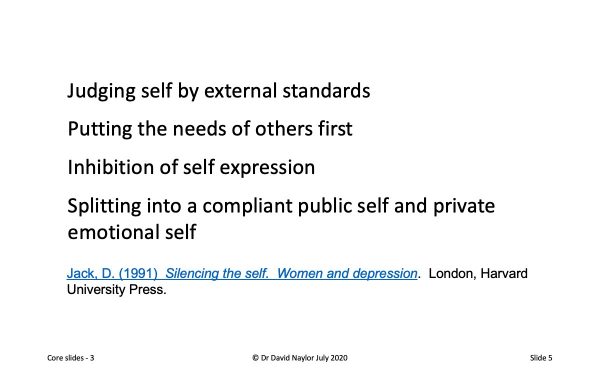
This section explores the consequence of bullying and incivility – we can be silenced. What we know, what we have noticed, is no longer put into words. Our observations, our thoughts and feelings, are no longer part of the conversation. Leading to decisions being made on less data than usual. This has implications for keeping people safer. Even more problematic for safety is the false assumption that silence is the same as agreement.
This section is an opportunity to have a conversation about what people have been silent about and how this silencing, this pressure to conform, happens via everyday behaviours taken to be the norm around here.
Robert Francis, whose report has dominated the NHS safety landscape noted (slide 2) that ‘the word “hindsight” occurs at least 123 times in the transcript of the oral hearings…and “benefit of hindsight” 378 times’ (‘Report of the Mid Staffordshire NHS Foundation Trust Public Inquiry Francis’, 2013, p.24). From this, we can assume; that we notice more than we routinely talk about and that a focused inquiry could reveal more.
It is not enough to tell people to speak up. That does not overcome the mechanism to self-censor.


Slide 3 is an opportunity to talk about the role of fear in organisational experience. (See: House of Commons, 2020. Report of the Independent Inquiry into the issues raised by Paterson. p.139) The fear of being cast out of the group and the fear of being punished for going against the grain. There is an example of this in my story ‘The case of the missing finance director’ here.
Slide 4 is based on my research in 2008 on constructively awkward people. People who could resist being silenced; who could resist the inner voice to shut up; who could say difficult things and sustain the conversation and relationship. It can be helpful to ask people if they have this sort of inner (reflexive) voice and what it tells them to do and not do. Such a voice is entirely normal and helps us ask an important question, that can build our capacity to resist being silenced and to question: ‘What is being asked of me in this situation and what sort of group am I part of right now?’ (See: McKie, A. 2004. ‘The demolition of man’: Lessons form Holocaust literature for the teaching of nursing ethics., Nursing Ethics. 11 (2) p.140.)

The meaning of plonker is to be foolish. It can be helpful to note that the Fool is an honourable role in many cultures. A person allowed to speak truth to power and not in a whisper. Any sane and historically informed leader will know that this is important in combatting hubris (See: Boxer and Palmer, 1994. ‘Meeting the Challenge of the Case’).

Slide 5 is another slide to explore the internal process by which we can silence ourselves and how this can lead us to act as a bystander (See: Jack, D. (1991) Silencing the self. Women and depression. London, Harvard University Press.) Judging by external standards is to assume others do not think or feel the same about what is going on. This is not a reliable assumption. It speaks to the risk of people in a group or team meeting all making this judgement. A judgment that can be tested by saying something and noticing what happens. But this brave step does not mean people will speak and overcome the anxiety of being different. Different in a culture that does not reward such behaviour; as in – what is really going on here?
Putting the needs of others first may be as simple as everyone’s tired and busy, they do not need to hear from me. This links to an inhibition of how we express ourselves. We go quiet, we swallow our rage at being spoken to like we are nothing.
The splitting into a compliant public self and what we think and feel in private is an important line of inquiry when investigating poor behaviours. An astute manager will be curious about what gets put in the informal spaces of a meeting, a team or wider organisation. As in clues about what we do not want to think about around here; and how this silencing is achieved by whom and on whose authority.
Slide 6 is linked to slide 5. More about the quality of silence as an intervention in response to the sense that questioning is not welcomed and enforced by bullying and incivility. Silence can be an act of the powerful. I do not need to act because the world is run pretty much according to my values. I’m fine. You can say what you like but nothing will change (See: Macalpine and Marsh, 2005. ‘On being white: There is nothing I can say’. Exploring whiteness and power in organisations. Management Learning, 36(4), pp. 429-450). I may recognise this state of affairs and realise my intervention is not worth the risk. Silence is also about fear. Fear of retribution and protecting others who I like and rely on.
The key issue raised by these two slides is silence always needs investigating. It is always purposeful if we can be bothered to look and ask.


Slide 7 reinforces the message about who and what may be lost to the public sphere of conversation in an organisation, team meeting etc. Silence should not be assumed to signal agreement.
Download my slides for ‘How we can go silent’ here, but please acknowledge the source.
Get in touch
Trying to find a way to deal with unprofessional behaviours can feel daunting. If you would like to chat to me about how I or my colleagues could help, you can contact me here.